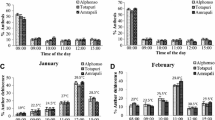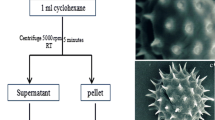Abstract
Stigma development in sunflower is accompanied with an accumulation of calcium (33 %), potassium (37 %) and boron (62 %) in mature stigma as compared to stigma at bud stage, thereby demonstrating their essential roles in attaining receptivity. Membrane-bound calcium accumulation is enhanced on the pellicle and is also evident in the cytoplasm accompanying stigma maturation. Total soluble carbohydrate content increases in the staminate stage (55 %) as compared to bud stage. Glucose and fructose are the major monosaccharides and their contents are maximum in the staminate stage. Total lipid content also increases with the passage of stigma development. Erucic acid (22:1) is expressed specifically in the bud and staminate stages. A variation in the contents of triacylglycerides and free fatty acids, and expression of fatty acyl esterases in mature stigma have been correlated with biochemical events associated with signalling mechanisms. Lastly, enhanced expression of two hydrolytic enzymes, namely β-1,3 glucanase and fatty acyl ester hydrolase, has been observed to correlate with stigma maturation. Present findings, thus, provide new information on the structural and biochemical changes marking various signalling events associated with successful pollen–stigma interaction.





Similar content being viewed by others
References
Acar I, Ak BE, Sarpkaya K (2010) Effects of boron and gibberellic acid on in vitro pollen germination of pistachio (Pistacia vera L.). Afr J Biotechnol 9:5126–5130
Al-Amery MM, Hamza JH, Fuller MP (2011) Effect of boron foliar application on reproductive growth of sunflower (Helianthus annuus L.). Int J Agron 230712. doi:10.1155/2011/230712
Allen AM, Lexer C, Hiscock SJ (2010) Comparative analysis of pistil transcriptomes reveals conserved and novel genes expressed in dry, wet, and semidry stigmas. Plant Physiol 154:1347–1360
Allen AM, Thorogood CJ, Hegarty MJ, Lexer C, Hiscock SJ (2011) Pollen-pistil interactions and self-incompatibility in Asteraceae: new insights from studies of Senecio squalidus (Oxford ragwort). Ann Bot 108:687–698
Ameele RJ (1982) The transmitting tract in Gladiolus. 1. The stigma and the pollen–stigma interaction. Am J Bot 69:389–401
Ashley MK, Grant M, Grabov A (2006) Plant responses to potassium deficiencies: a role for potassium transport proteins. J Exp Bot 57:425–436
Bednarska E (1989) Localization of calcium on the stigma surface of Ruscus aculeatus L. Planta 179:11–16
Bhattacharya A, Mandal S (2004) Pollination, pollen germination and stigma receptivity in Moringa oleifera Lamk. Grana 43:48–56
Bílková J, Albrechtová J, Opatrná J (1999) Histochemical detection and image analysis of non-specific esterase activity and the amount of polyphenols during annual bud development in Norway spruce. J Exp Bot 50:1129–1138
Bolaños L, Lukaszewski K, Bonilla I, Blevins D (2004) Why boron? Plant Physiol Biochem 42:907–912
Bradford MM (1976) A rapid and sensitive method for the quantitation of microgram quantities of protein utilizing the principle of protein-dye binding. Anal Biochem 72:248–254
Bucciaglia PA, Zimmermann E, Smith AG (2003) Functional analysis of a beta-1,3-glucanase gene (Tag1) with anther-specific RNA and protein accumulation using antisense RNA inhibition. J Plant Physiol 160:1367–1373
Chatterjee C, Nautiyal N (2000) Developmental aberrations in seeds of boron deficient sunflower and recovery. J Plant Nutr 23:835–841
Couée I, Sulmon C, Gouesbet G, Amrani AE (2006) Involvement of soluble sugars in reactive oxygen species balance and responses to oxidative stress in plants. J Exp Bot 57:449–459
Cresti M, Keijzer CJ, Tiezzi A, Ciampolini F, Focardi S (1986) Stigma of Nicotiana: ultrastructural and biochemical studies. Am J Bot 73:1713–1722
Dafni A, Maués MM (1998) A rapid and simple procedure to determine stigma receptivity. Sex Plant Reprod 11:177–180
David A, Yadav S, Bhatla SC (2010) Sodium chloride stress induces nitric oxide accumulation in root tips and oil body surface accompanying slower oleosin degradation in sunflower seedlings. Physiol Plant 140:342–354
Delp G, Palva ET (1999) A novel flower-specific Arabidopsis gene related to both pathogen-induced and developmentally regulated plant β-1,3-glucanase genes. Plant Mol Biol 39:565–575
Dickinson HG (2000) Pollen stigma interactions so near yet so far. Trends Genet 16:373–376
Dumas C (1977) Lipochemistry of the programic stage of a self-incompatible species: neutral lipids and fatty acids of the secretory stigma during its glandular activity, and of the solid style, the ovary and the anther in Forsythia intermedia Zab. (Heterostylic species). Planta 137:177–184
Dumas C, Knox RB (1983) Callose and determination of pistil viability and incompatibility. Theor Appl Genet 67:1–10
Feder N, O’Brien TP (1968) Plant microtechnique: some principles and new methods. Am J Bot 55:123–142
García-Hernández ER, López GIC (2005) Structural cell wall proteins from five pollen species and their relationship with boron. Braz J Plant Physiol 17:375–381
Ghosh S, Shivanna KR (1984) Structure and cytochemistry of stigma and pollen-pistil interaction in Zephyranthes. Ann Bot 53:91–106
Gomez L, Rubio E, Augé M (2002) A new procedure for extraction and measurement of soluble sugars in ligneous plants. J Sci Food Agric 82:360–369
Gupta UC (1998) Determination of boron, molybdenum and selenium in plant tissue. In: Kalra YP (ed) Handbook of reference methods for plant analysis. CRC Press, Florida, pp 172–174
Gupta V, Mukhopadhyay A, Arumugam N, Sodhi YS, Pental D, Pradhan AK (2004) Molecular tagging of erucic acid trait in oilseed mustard (Brassica juncea) by QTL mapping and single nucleotide polymorphisms in FAE1 gene. Theor Appl Genet 108:743–749
Halder NK, Farid ATM, Siddiky (2008) Effect of boron for correcting the deformed shape and size of Jackfruit. J Agric Rural Dev 6:37–42
Hara A, Radin NS (1978) Lipid extraction of tissues with a low-toxicity solvent. Anal Biochem 90:420–426
Heslop-Harrison JS, Reger BJ (1986) Chloride and potassium ions and turgidity in the grass stigma. J Plant Physiol 124:55–60
Higashiyama T (2010) Peptide signaling in pollen-pistil interactions. Plant Cell Physiol 51:177–189
Hiscock SJ, Allen AM (2008) Diverse cell signalling pathways regulate pollen–stigma interactions: the search for consensus. New Phytol 179:286–317
Hiscock SJ, Hoedemaekers K, Friedman WE, Dickinson HG (2002a) The stigma surface and pollen–stigma interactions in Senecio squalidus L. (Asteraceae) following cross (compatible) and self (incompatible) pollinations. Int J Plant Sci 163:1–16
Hiscock SJ, Bown D, Gurr SJ, Dickinson HG (2002b) Serine esterases are required for pollen tube penetration of the stigma in Brassica. Sex Plant Reprod 15:65–74
Horneck DA, Hanson D (1998) Determination of potassium and sodium by flame emission spectrophotometry. In: Kalra YP (ed) Handbook of reference methods for plant analysis. CRC Press, Florida, pp 153–156
Huang L, Bell RW, Dell B (2009) Exploring the physiological basis for high reproduction sensitivity to boron deficiency in plants. In: Proceedings of international plant nutrition ColloquiumXVI, Davis, California
Kalra G, Bhatla SC (1999) Distribution of membrane-bound calcium and activated calmodulin in cultured portoplasts of sunflower (Helianthus annuus L.). Curr Sci 76:1580–1584
Kandasamy MK, Kristen U (1987) Developmental aspects of ultrastructure, histochemistry and receptivity of the stigma of Nicotiana sylvestris. Ann Bot 60:427–437
Knox RB, Clarke A, Harrison S, Smith P, Marchalonis JJ (1976) Cell recognition in plants: determinants of the stigma surface and their pollen interactions. Proc Natl Acad Sci USA 73:2788–2792
Kräuter-Canham R, Bronner R, Steinmetz A (2001) SF21 is a protein which exhibits a dual nuclear and cytoplasmic localization in developing pistils of sunflower and tobacco. Ann Bot 87:241–249
Lavithis M, Bhalla PL (1995) Esterases in pollen and stigma of Brassica. Sex Plant Reprod 8:289–298
Lenartowska M, Rodríguez-García MI, Bednarska E (2001) Immunocytochemical localization of esterified and unesterified pectins in unpollinated and pollinated styles of Petunia hybrida Hort. Planta 213:182–191
Lotan T, Ori N, Fluhr R (1989) Pathogenesis-related proteins are developmentally regulated in tobacco flowers. Plant Cell 1:881–887
McConn M, Browse J (1996) The critical requirement of linolenic acid is pollen development, not photosynthesis, in an Arabidopsis mutant. Plant Cell 8:403–416
McInnis SM, Desikan R, Hancock JT, Hiscock SJ (2006) Production of reactive oxygen species and reactive nitrogen species by angiosperm stigmas and pollen: potential signalling crosstalk? New Phytol 172:221–228
Miller GL (1959) Use of dinitrosalicylic acid reagent for determination of reducing sugar. Anal Chem 31:426–428
Morohashi Y, Matsushima H (2000) Development of beta-1,3-glucanase activity in germinated tomato seeds. J Exp Bot 51:1381–1387
Ramasubbu R, Sreekala AK, Pandurangan AG (2010) Biochemical analysis of stigma of three endemic and endangered Impatiens L. J Biosci Res 1:13–16
Rehman S, Yun SJ (2006) Developmental regulation of K accumulation in pollen, anthers, and papillae: are anther dehiscence, papillae hydration, and pollen swelling leading to pollination and fertilization in barley (Hordeum vulgare L.) regulated by changes in K concentration? J Exp Bot 57:1315–1321
Rotisch T (1999) Source-sink regulation by sugar and stress. Curr Opin Plant Biol 2:198–206
Sage TL, Hristova-Sarkovski K, Koehl V, Lyew J, Pontieri V, Bernhardt P, Weston P, Bagha S, Chiu G (2009) Transmitting tissue architecture in basal-relictual angiosperms: implications for transmitting tissue origins. Am J Bot 96:183–206
Sang YL, Xu M, Ma FF, Xu XH, Gao X-Q, Zhang XS (2012) Comparative proteomic analysis reveals similar and distinct features of proteins in dry and wet stigmas. Proteomics 12:1983–1998
Schneiter AA, Miller JF (1981) Description of sunflower growth stages. Crop Sci 21:901–903
Shakya R, Bhatla SC (2010) A comparative analysis of the distribution and composition of lipidic constituents and associated enzymes in pollen and stigma of sunflower. Sex Plant Reprod 23:163–172
Sharma B, Bhatla SC (2013a) Accumulation and scavenging of reactive oxygen species and nitric oxide correlate with stigma maturation and pollen–stigma interaction in sunflower. Acta Physiol Plant 35:2777–2787
Sharma B, Bhatla SC (2013b) Structural analysis of stigma development in relation with pollen–stigma interaction in sunflower. Flora 208:420–429
Silvério A, Mariath JEA (2010) The formation of the stigmatic surface in Passiflora elegans (Passifloraceae). Rudriguésia 61:569–574
Teixeira SP, Capucho LC, Machado SR (2011) Two novel reports of semidry stigmatic surface in Asteraceae. Flora 206:328–333
Trevelyan WE, Harrison JS (1952) Studies on yeast metabolism. I. Fractionation and microdetermination of cell carbohydrates. Biochem J 50:298–303
Tucker MR, Paech NA, Willemse MTM, Koltunow AMG (2001) Dynamics of callose deposition and β-1,3-glucanase expression during reproductive events in sexual and apomictic Hieracium. Planta 212:487–498
Wakelin AM, Leung DWM (2009) β-1,3-Glucanase activity in the stigma of healthy petunia flowers. Biol Plant 51:69–74
Watson ME (1998) Boron. In: Brown JR (ed) Recommended chemical soil test procedures for the north central region. Missouri agricultural experiment station SB 1001, Columbia, pp 445–448
Willats WG, McCartney L, Mackie W, Knox JP (2001) Pectin: cell biology and prospects for functional analysis. Plant Mol Biol 47:9–27
Wolters-Arts M, Lush WM, Mariani C (1998) Lipids are required for directional pollen-tube growth. Nature 392:818–821
Acknowledgments
Digital imaging work was undertaken on the photomicroscope provided by Alexander von Humboldt Foundation (Germany) to SCB. Thanks are due to Dr. Rashmi Shakya for help in various ways. GC was carried out with help of Dr. Y.S. Sodhi, Center for Genetic Manipulation of Crop plants, Delhi. This work was supported by University Grants Commission (UGC) and MM (PG) College, Modinagar in the form of teacher research fellowship to BS.
Author information
Authors and Affiliations
Corresponding author
Additional information
Communicated by J. V. Huylenbroeck.
Rights and permissions
About this article
Cite this article
Sharma, B., Bhatla, S.C. Elemental and biochemical markers of stigma receptivity in sunflower. Acta Physiol Plant 36, 1299–1311 (2014). https://doi.org/10.1007/s11738-014-1504-1
Received:
Revised:
Accepted:
Published:
Issue Date:
DOI: https://doi.org/10.1007/s11738-014-1504-1




